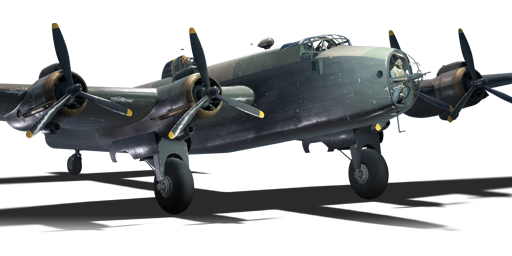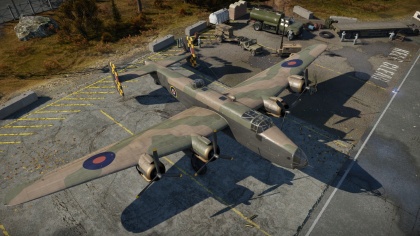Difference between revisions of "Halifax B Mk IIIa"
(→Pros and cons: Condensed list) |
(→Flight Performance: Upgraded section of the chart has been filled) (Tag: Visual edit) |
||
| Line 48: | Line 48: | ||
! RB | ! RB | ||
|- | |- | ||
| − | | | + | | 477 || 454 || {{Specs|ceiling}} || 33.2 || 34.0 || 9.9 || 6.5 ||750 |
|- | |- | ||
|} | |} | ||
| Line 223: | Line 223: | ||
'''Pros:''' | '''Pros:''' | ||
| + | |||
* Versatile - It is capable of flying low-altitude runs for minibases, or high-altitude bomb runs. | * Versatile - It is capable of flying low-altitude runs for minibases, or high-altitude bomb runs. | ||
* Can carry an overwhelming '''12,000 lb''' of bombs, giving it the heaviest payload at RanK II-III, and outclasses many Rank IV bombers | * Can carry an overwhelming '''12,000 lb''' of bombs, giving it the heaviest payload at RanK II-III, and outclasses many Rank IV bombers | ||
Revision as of 17:40, 16 June 2019
Contents
Description
The Halifax B Mk IIIa is a Rank British bomber
with a battle rating of (AB), (RB), and (SB). This aircraft was introduced in Update 1.59 "Flaming Arrows".
The Halifax is an interesting member of the British bomber line. It is the first true British heavy bomber, a big change from its predecessors, which are all either flying boats, medium, or light bombers. With the transition to heavy bombers, comes a change in tactics. The Halifax will out class almost every tier 2 and 3 bomber in terms of payload. It will also generally beat every same BR bomber in payload as well. However, being a heavy bomber has its draw backs. Compared to nearly all previous British bombers, this one is slower, and has a noticeably slow climb rate. While the payload upgrade is nice, the Halifax is not very durable. Worse, the Halifax lacks effective defensive weapons, a flaw of nearly all British bombers. The main priority, as a result, should be targeting bases, and avoiding opposing pilots as much as possible. Use high altitude and less direct travel routes to get to your targets. If you are engaged, your defensive guns can save you, but they are not very reliable. In addition, you have no ventral turret, leaving a massive defensive gap. If you can keep safe, and deliver your payload, you will find this to be a very effective bomber.
General info
Flight Performance
| Characteristics | |||||||
|---|---|---|---|---|---|---|---|
| Stock | |||||||
| Max Speed (km/h at 4,115 m) |
Max altitude (meters) |
Turn time (seconds) |
Rate of climb (meters/second) |
Take-off run (meters) | |||
| AB | RB | AB | RB | AB | RB | ||
| 432 | 418 | 35.3 | 35.8 | 2.3 | 3.8 | 750 | |
| Upgraded | |||||||
| Max Speed (km/h at 4,115 m) |
Max altitude (meters) | Turn time (seconds) | Rate of climb (meters/second) |
Take-off run (meters) | |||
| AB | RB | AB | RB | AB | RB | ||
| 477 | 454 | 33.2 | 34.0 | 9.9 | 6.5 | 750 | |
Details
| Features | ||||
|---|---|---|---|---|
| Combat flap | Take-off flap | Landing flap | Air brakes | Arrestor gear |
| ✓ | ✓ | ✓ | X | X |
| Limits | ||||
|---|---|---|---|---|
| Wing-break speed (km/h) |
Gear limit (km/h) |
Combat flap (km/h) |
Max Static G | |
| + | - | |||
| ??? | ~?? | ~? | ||
| Optimal velocities | |||
|---|---|---|---|
| Ailerons (km/h) |
Rudder (km/h) |
Elevators (km/h) |
Radiator (km/h) |
| < ??? | < ??? | < ??? | > ??? |
| Compressor (RB/SB) | ||
|---|---|---|
| Setting 1 | ||
| Optimal altitude | 100% Engine power | WEP Engine power |
| 2,000 m | ??? hp | ?,??? hp |
| Setting 2 | ||
| Optimal altitude | 100% Engine power | WEP Engine power |
| 4,300 m | ?,??? hp | ?,??? hp |
Survivability and armour
- 6.35 mm steel in front and floor of cockpit
- 8 mm steel behind pilot and in rear fuselage bulkhead
- No armour glazing
- Critical components located in the wings of aircraft (fuel, engine, controls)
Armaments
Suspended armament
The Halifax B Mk IIIa can be outfitted with the following ordinance"
- 15 x G.P 250 lb Mk.IV bombs
- 15 x G.P 500 lb Mk.IV bombs
- 9 x M.C. 1000 lb Mk.I bombs + 6 x G.P 500 lb Mk.IV bombs
Defensive armament
The Halifax B Mk IIIa is defended by:
- 4 x 7.7mm Browning machine gun, tail turret (1,700 RPG= 6,800 total)
- 4 x 7.7mm Browning machine gun, dorsal turret (600 RPG = 2,400 total)
- 1 x 7.7mm Vickers K machine gun, nose turret (1000 RPG)
Usage in the battles
Manual Engine Control
| MEC elements | ||||||
|---|---|---|---|---|---|---|
| Mixer | Pitch | Radiator | Supercharger | Turbocharger | ||
| Oil | Water | Type | ||||
| Controllable | Not controllable | Not controllable | Not controllable | Separate | Not ontrollable | Not controllable |
Modules
| Tier | Flight performance | Survivability | Weaponry | ||
|---|---|---|---|---|---|
| I | Fuselage Repair | Radiator | |||
| II | Compressor | Airframe | |||
| III | Wings Repair | Engine | |||
| IV | Engine Injection | Cover | |||
Pros and cons
Pros:
- Versatile - It is capable of flying low-altitude runs for minibases, or high-altitude bomb runs.
- Can carry an overwhelming 12,000 lb of bombs, giving it the heaviest payload at RanK II-III, and outclasses many Rank IV bombers
- (Realistic Battle) Full payload lets it take out all three bases in one pass with two 1,000 lb bombs to spare (first base : 6 x 500 lb + 1 x 1,000 lb / second base : 3 x 1,000 lb / third base : 3 x 1,000 lb / airfield : 2 x 1,000 lb.
- Fast and fairly manoeuvrable for a heavy bomber, with flaps that do not rip easily
- Performance is almost unaffected by payload options due to internal payload carriage that doesn't create drag
- Fantastic climb rate with WEP; can easily reach 6,000 m with full payload just by side climbing (which is heavily advised to minimize interception)
- Can fly with two engines if needed - or even one, if trying to land.
- Matchmaking typically places the bomber against planes less deadly than the ones later British bombers face
- Defensive armament is decent for a British bomber
- Tail gunner has a lot of ammunition (4 x 7.7 mm machine guns with 1,700 rounds per gun)
- Impressive aircraft overall in terms of bombers, arguably outclassing the succeeding Stirling in the next rank and can be a game changer for the team if left unchecked
- Economical plane to fly as an easy Silver Lion and Research Points grinder with an incredibly cheap repair cost
Cons:
- Large target
- Priority target (in Arcade battle) that smart players will aim for first
- Stock payload is useless for base bombing
- Nose is defended by a single 7.7 mm gun and the belly has no machine gun coverage, leaving them very vulnerable for enemy attacks
- 7.7 mm turrets are overall not very effective
- Only one pilot, no copilot like other bombers
- WEP causes overheating unless manual engine control is used to force radiators open
- Fragile structure compared to most competing bombers and previous British bombers
- Severe lack of armour for crew leaves them vulnerable
History
Describe the history of the creation and combat usage of the aircraft in more detail than in the introduction. If the historical reference turns out to be too big, take it to a separate article, taking a link to an article about the vehicle and adding a block "/ historical reference" (example: https://wiki.warthunder.com/Name-vehicles/historical reference) and add a link to it here using the main template. Be sure to include links to sources at the end of the article.
Media
An excellent addition to the article will be video guides, as well as screenshots from the game and photos.
Read also
Links to the articles on the War Thunder Wiki that you think will be useful for the reader, for example,
- reference to the series of the aircraft;
- links to approximate analogues of other nations and research trees.
Sources
Paste links to sources and external resources, such as:
- topic on the official game forum;
- page on aircraft encyclopedia;
- other literature.
| Britain bombers | |
|---|---|
| Torpedo | Swordfish Mk I · Swordfish Mk II · ▄Avenger Mk II |
| Dive | V-156-B1 |
| Hydroplanes | ▄Catalina Mk IIIa · Sunderland Mk IIIa · Sunderland Mk V |
| Light | Blenheim Mk IV · Beaufort Mk VIII · ▄Hudson Mk V · Brigand B 1 |
| Based on A20 | ▄Havoc Mk I · ▄Boston Mk I · ▄DB-7 |
| Hampden | Hampden Mk I · Hampden TB Mk I |
| Wellington | Wellington Mk Ic · Wellington Mk Ic/L · Wellington Mk III · Wellington Mk X |
| Halifax | Halifax B Mk IIIa |
| Stirling | Stirling B Mk I · Stirling B Mk III |
| Lancaster | Lancaster B Mk I · Lancaster B Mk III |
| Lincoln | Lincoln B Mk II |
| Shackleton | Shackleton MR.Mk.2 |





